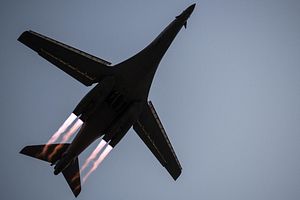On Friday, two U.S. long-range strategic bombers flew over parts of the South China Sea, asserting freedom of overflight over disputed waters.
The United States Air Force sent two B-1B Lancer bombers from Andersen Air Force Base in Guam in the Western Pacific to the South China Sea for a routine flight as U.S. President Donald J. Trump prepared to meet Chinese President Xi Jinping on the sidelines of the Group of 20 meeting in Hamburg, Germany.
Friday’s bomber flight comes shortly after the latest U.S. freedom of navigation operation by the U.S. Navy on the surface of the South China Sea, which involved the USS Stethem conducting an innocent passage within 12 nautical miles of Triton Island in the Paracel Islands.
The U.S. Navy conducted a similar operation in May, when the USS Dewey, another Arleigh Burke-class guided missile destroyer, asserted high seas freedoms around Mischief Reef in the Spratly Group, the site of one of China’s seven artificial islands.
The latest B-1B Lancer flyover of the South China Sea echoes a similar operation in May as well.
In another incident in May, a U.S. B-1B flying over the East China Sea, where China also is involved in territorial disputes with Japan, received warnings from Chinese authorities. China declared an air defense identification zone over much of the East China Sea in November 2013.
The Chinese Foreign Ministry reacted negatively to the flight by the B-1 bombers, with Foreign Ministry spokesperson Geng Shuang saying that “China resolutely opposes individual countries using the banner of freedom of navigation and overflight to flaunt military force and harm China’s sovereignty and security.”
The Chinese Defense Ministry, in a statement released to Reuters, noted that it “effectively monitors relevant countries’ military activities next to China.” “The Chinese military will resolutely safeguard national sovereignty and security as well as regional peace and stability,” it added.
The B-1B, though often erroneously cited as a nuclear-capable bomber, has not been slated for a nuclear delivery mission since the early 1990s.
Beginning in 2007, the existing B-1 bomber fleet underwent physical conversion to a conventional-only delivery platform — a process that was completed in 2011.
The changes to the bombers in the late-2000s physically prevent it from being reequipped for the delivery of nuclear air-launched cruise missiles or other nuclear ordnance.
The United States military has conducted surface transits by naval vessels and flyovers by military aircraft to protest excessive claims by regional states, including China.
The United States does not take any position about which South China Sea claimant state is the rightful owner of any given feature, but does see the preservation of freedom of navigation and overflight as a core interest.

































